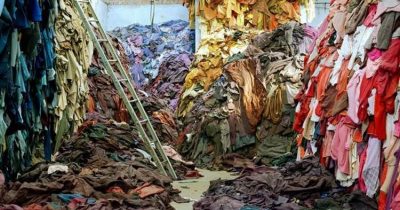
A Message from the Other Side of the World: The Truth Behind Fast Fashion
In the past, “fashion” was the privilege only enjoyed by the rich. However, people have started to imitate and focus on the fashion trend since the 20th century. With the bustle and hustle paces in the contemporary capitalist society, fast fashion has gradually risen and become affordable to everyone. Rapid production, high elimination rate, and low prices are the main characteristics of “fast fashion.” It is such a good turn that fashion is no longer the privilege for the rich. Thus, shoppers can snap the clothes up while they are in high popularity. As time passes, the idea of outfit repeating is a fashion faux pas has been played into people’s minds. If you want to stay in fashion, you have to sport the latest looks as they happen. As a result, people start to be used to discard clothes after a few wears. You may hear that fast fashion is an environmental killer or a threat to human rights. You may also hear of sustainability and sustainable fashion. However, do you know the stories behind these words and the reasons for their rising? Or do you really understand what is sustainability and sustainable fashion?

Fast Fashion Trend. From The Trend Spotter
As usual, Camille and her friends went to their favorite fast fashion brands to shop for the latest season clothes. They all returned with fruitful results and happiness. However, a small slice of paper fell out of the pocket of Camille’s new jacket when she was about to cut the tag on the jacket. The paper was simply written “SOS! PLEASE HELP ME”. This had shocked Camille, she could not help but wonder who put this paper in the jacket and what difficulty he or she was encountering. As a journalist, she wanted to figure out the story behind this tag and the inside story of her favorite industry “fast fashion”. Let’s start the discovery from the place of production of the jacket “Cambodia”.
Labour Exploitation
Bopha is a twelve-years-old girl living in Cambodia. In this period, she should receive education and live in a carefree childhood as other twelve-years-old children. Instead, she has to work in the garment factory of fast fashion companies for twelve to fourteen hours a day due to her livelihood. Under the pressure of economic condition, she becomes a part of the fast fashion supply chain. Worst of all, her salary is only 0.5 US dollars per day. However, Bopha is not the only child being oppressed in the fast fashion era. There are currently about 170 million children facing the same situation as Bopha in the apparel industry around the world. They are forced to work overtime without rest and overtime pay at such a young age.

Child Labour, Bopha. From Ingabagepalli.com
The conditions of adult workers are no better than child labor. Nusrat is a novice mother from Bangladesh, her baby is only 5 months old. Nusrat has no choice but to take her baby to factories to work because nobody can take care of her baby and she has to make money for her family and baby. Yet, the conditions and environment of the factory are very poor. Nusrat is also a lucky survivor in the 2013 Dhaka garment factory collapsed. Dhaka garment factory is the most representative case for fast fashion factories, these workers struggle to survive on extremely low pay, suffering appalling poor working conditions, excessive hours, and are denied basic trade union rights. 80% of workers work until 8 pm or 10 pm, after starting at 8 am without rest.
Water Pollution

Citarum River. From gvn.com.tw
Sofiyanto has lived in a small village nearby Citarum River in Indonesia for more than 50 years. In his memories, Citarum River was a clean and vibrant river, however, it has become one of the most toxic and dirtiest rivers in the world. Moreover, the number of babies with birth defects has gradually increased in recent years, includes his grandchildren. Nowadays, Citarum River is a poisonous river full of chemicals such as lead, mercury, arsenic, etc., and organisms cannot survive at all. The main source of pollution comes from the hundreds of textile factories around the riverbed. It is also a great threat to tens of thousands of residents around Citarum River to suffer from serious health effects.
Citarum River is not the only case polluted by the fast fashion industry. Textile dyeing is the world’s second-largest polluter of water since the water leftover from the dyeing process is often dumped into ditches, streams, or rivers. The dyeing process uses enough water to fill 2 million Olympic-sized swimming pools each year. Thus, the textile treatment and dyeing process produce an average of 20% of all industrial water pollution. Throughout the world, the fashion industry uses around 8,000 synthetic chemicals to transform raw textiles into wearable items. However, many of these chemicals reach freshwater sources and many of them are impossible to clean and remove.
The stories of Bopha, Nusrat, and Sofiyanto are just part of the impacts which fast fashion industry cause. There are more impacts that people may not aware of.
Pesticide Pollution and Water Consumption

Cotton. From Cotton Australia
Cotton is the most commonly used natural fiber in the world, accounting for about 40% of the ingredients in clothes. Yet, it can be one of the most unsustainable crops in the world. It is an economic crop that needs more water than other plants, and it is also the variety that requires the most chemicals to perfect its growth. The water consumption of producing a cotton T-shirt can reach 2,700 liters and a pair of jeans takes up to 7,000 liters of water to produce. Although only 2.4% of the farmland in the world grows cotton, it consumes 10% of agrochemicals and 25% of pesticides. We are increasing our personal use and depleting our useable supplies of water at such a rate that demand will outstrip supply by 2030.
Carbon Footprint
Besides cotton, many of those fibers are polyester, a plastic found in an estimated 60% of garments. Producing polyester releases two to three times more carbon emissions than cotton, and it also takes hundreds of years to degrade. Fast fashion has annually produced 10% of the total carbon emission worldwide, which is more than the combination of international flights and maritime shipping.
Landfills and Waste

Fast Fashion Landfill. From UQ Sustainability
According to the Textile Recycling Committee, 12 million tons of used clothes waste are generated a year in the United States, but only 15% of this is recycled or donated to charities, and the other 85% goes to landfills. That’s enough to fill the Sydney Harbor. Most of the clothes end up in the dump. The equivalent of one garbage truck full of clothes is burned or dumped in a landfill every second.
What is “Sustainability” and “Sustainable Fashion?”
Sustainability is established based on three pillars: people, planet, and profit. Which refers to the process that people maintain environmental balance while meeting human needs and future development. Sustainability can be an idea, the nature of a life system, a production method, or a way of life. It has become a popular and highly promoted issue in recent years, as a result, the sustainable concept in different industries has gradually risen.

Three pillars of sustainability. From Medium.
Sustainable fashion is one of them, it has become highly discussed since 2013. People started to realize the environmental damage and human rights injustice caused by fast fashion. Sustainable fashion refers to clothing that is designed, manufactured, distributed, and used in environmentally friendly ways. Garments and individual behavior have been made in a way that is mindful of the many environmental issues the fashion industry touches upon.

ZARA Join Life Sustainable Collection
What can we do?
- Donated or resell your unwanted clothes
- Take the 333-time capsule challenge and 30 wears test
- Go for quality over quantity. Slow fashion trumps fast fashion.
- Support fashion brands that are ethical and environmentally conscious.
- Read the labels and learn how to recognise sustainable materials when shopping.
- Purchase the clothes with certified materials by Fairtrade, such as organic cotton
- Transform old clothes into new garments
- Shop less Think more
Nobody should be sacrificed for our clothes, not Bopha, not Nusrat, and not Sofiyanto. Not for the biggest victims, the Earth either. These are the messages from the other side of the world. Treat fashion with caution and become a more conscientious consumer. Don’t become a murderer of the environment and a perpetrator of the labor market. Fashion is life, and it is worthy of our heart to understand its meaning. Fashion is not cheap, someone, somewhere, is paying. We need the earth, but the earth does not need us.

